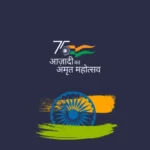Top 10 historical places in India which played major role in India’s Independence:In the past 500+ years, Indian states were ruled by different dynasties and each of the Kings and Emperors built strong and huge forts and palaces for their living, ruling, and other administrative purposes. Each fort brings a rich heritage and culture of that era. It reminds us how prominent and skilled Indian craftsmen were even in ancient times. Many of the forts are not only important for the Indian Government but are UNESCO heritage and require proper care. Each fort carries a story from the luxurious lifestyle of the rulers to the sacrifice of people in the name of pride and honour. On 75 years of Independence “Azadi ka Amrit Mahotsav”, let’s visit the top 10 historical places in India which played major role in India Independence and free our country from foreign Invaders.
The Jhansi Fort: A Siege to Remember

When we first see it, we are reminded of Rani Lakshmibai, the warrior queen who stood up to Britain. Resistance gathered around her during the Indian Revolt of 1857, also known as the First War of Independence in India. When it came to fighting against the British, she chose the Jhansi fort as her battleground.
A child of royal lineage named Anand Rao was adopted by Rani Lakshmibai and Gangadhar Rao after their marriage in 1842 CE (renamed Damodar Rao). A clever move by the British, who refused to recognise Damodar Rao as the legal heir to the Indian Empire after the Raja died in 1853, led to the annexation of India under the Doctrine of Lapse policy.
Revolutionaries in Meerut proclaimed Lakshmi Bai regent of Jhansi when the revolt broke out in 1857 CE. Supporters of the Rani flocked to Jhansi from the surrounding areas. As she and her supporters took control of the fort, she proudly declared, “mein apni Jhansi nahi dungi.” As the Company’s men surrounded the fort, the siege lasted several weeeks.

Kalpi and Gwalior were her first stops. She joined the rebels and fought against the British in both places. However, the British forces were able to defeat them and take control of the area. Rani is believed to have died while still fighting. Brits were still talking about her bravery after she died. In the words of Sir Hugh Rose: “She was a man among mutineers.” Lord Canning, India’s first Viceroy, wrote in his private papers, “She used to dress like a man (with a turban) and ride like one.”
Fortress Jhansi is a symbol of India’s resistance to British rule and unfair policies. In her palace, Rani Mahal, near the fort, weapons used in the siege of Jhansi fort are now on display. India’s sovereignty is embodied in this fort, which inspires its citizens to this day.
Red Fort
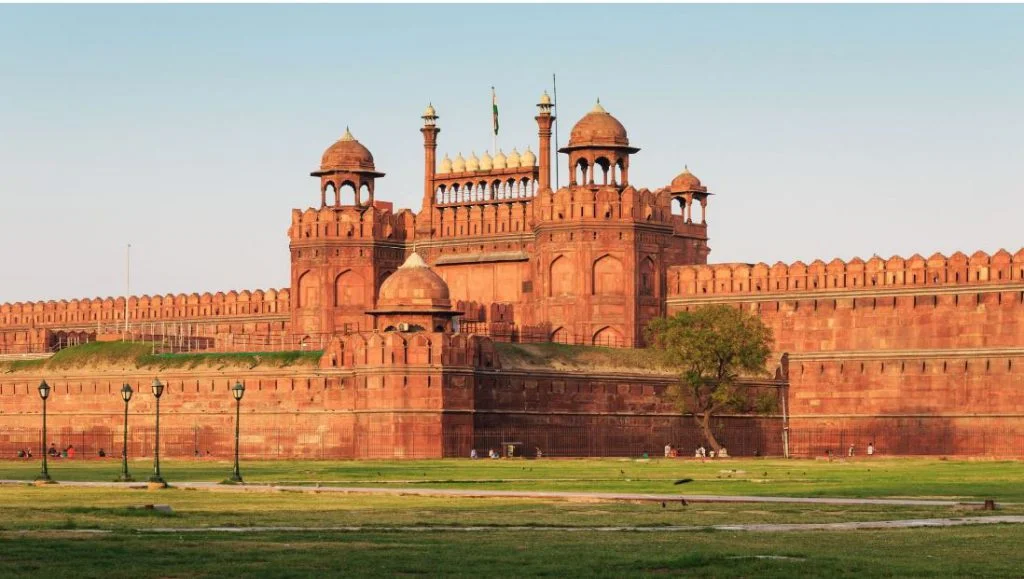
Red fort is named Lal Qal, ah also called Lal Kila or Lal Quila located in New Delhi. In 1638, Shah Jahan was the fifth Mughal emperor, construction on 12 May 1638, when he shifted capital Agra to Delhi. The fort construction starts on 13 May 1638 this is the Islamic month of Muharram and was completed on 6 April 1648. Red fort is designated a UNESCO World Heritage site in 2007. The fort is made of red sandstone originally made red and white, Ustad Ahmad Lahon was an architecture of fort who is also constructed, Taj Mahal. The Red Fort’s architectural style and innovative planning represent the zenith of Islamic architecture which, under the Shah Jahan, was brought to a new level of refinement. The fort has an area of 254.67 acres enclosed by 2.41 kilometers of walls and stand 75 feet high, encloses a complex of palaces and entertainment halls, projecting balconies, baths and indoor canals, and geometrical gardens, as well as a covered with a lot of small, complicated designs as decoration mosque. Among the most famous structures of the complex are the Hall of Public Audience (Diwan-i-Am), which has 60 red sandstone pillars supporting a flat roof, and the Hall of Private Audience (Diwan-i-Khas), which is smaller and has a pavilion of white marble. First Prime Minister of India, Jawaharlal Nehru On 15 August 1947, raised the Indian flag above the Lahori Gate. Every year on India’s Independence Day, the Prime Minister hoists the Indian at the fort’s main gate and delivers a national address to the nation.
Chittorgarh Fort

The Chittorgarh Fort is one of the largest forts in India, also known as Chittorgarh or Chittor. In beginning, the fort was the Mewar capital but present-day it is the town of Chittorgarh. In 2013, the fort was declared UNESCO World Heritage Site. It lies over a hill 180 m in height spread over an area of 691.9 acres, the circumference of 13 kilometers covering an area of 700 acres. fort situated on the left bank of the Berach River. The fort covers 65 different places inside the fort, four palaces, 19 large temples, 84 water bodies but only left 22 large water bodies, 4 memorials, and a few victory towers. Fort was different construction styles here – one that is purely Rajputana and the other that has Sisodian built in two phases. The fort has seven different gates in the local language, gate is called Pol these are Padan Pol, Bhairon Pol, Hanuman Pol, Ganesh Pol, Jolla Pol, Laxman Pol, and the main gate named the Ram Pol (Lord Rama’s Gate). The doors of the gates with pointed arches are reinforced to fend off elephants and cannon shots. The top of the gates has notched parapets for archers to shoot at the enemy army. The fort was built by a local Chitrangada Mori. Another perspective, the construction of a fort for the legendary hero Bhima, struck the ground here, which resulted in water springing up to form a large reservoir. The water formed by Bhima is an artificial tank called Bhimlat Kund…The Guhila ruler Bappa Rawal is said to have captured the fort in either 728 CE or 734 CE. One account state that he received the fort in dowry. Mughal Emperor Akbar attacked and sacked this fort, which was but one of the 84 forts of Mewar, but the capital was shifted to Aravalli hills where heavy artillery & cavalry were not effective. In 1303, Alauddin Khilaji captured Chittor after an eight-month-long siege. Some later legends state that Alauddin invaded Chittor to capture Ratna Simha’s beautiful queen Padmini, but most modern historians have rejected the authenticity of these legends. The legends also state that Padmini and other women committed suicide by Jauhar The fort and the city of Chittorgarh host the biggest Rajput festival called the “Jauhar Mela”, the anniversary of one of the Jauhars. It is generally believed that it commemorates Padmavati’s Jauhar, which is most famous. Chittorgarh Fort is the celebrated bravery of Rajput and jauhars.
Kumabalgarh Fort

Kumbhalgarh Fort is also known as the Great Wall of India, the second-longest wall of the world after the Great Wall of China, stand in Udaipur Rajasthan. It is the second-largest fort in India. The fort was built on a hilltop 1,100 m above sea level on the Aravalli range. The grand wall of Kumbhalgarh Fort is the longest wall in the world right after ‘The Great Wall of China. So, the fort is known as ‘The Great Wall of India’. The walls of the Kumbhalgarh Fort are 36 km in diameter making them one of the longest walls in the world. It is 15 m wide which is wide enough for eight horses to walk side by side. In 2013, at the 37th session of the World Heritage Committee, Kumbhalgarh Fort and five more forts of Rajasthan were affirmed a UNESCO World Heritage Site included in Hill Forts of Rajasthan. The fort was built by Rana Kumbha in the 15th century between AD 1443 and 1458. Mandan who leads the architecture of the fort was a very famous architect of that time. The fort was constructed in the exact same place as an old castle. There is a very interesting story when Rana Kumbha began constructing the fort, many difficulties after which he thought of giving up on the construction. One day, he met a holy man who told him not to give up faith and that one day all his difficulties would fade away provided a pure-hearted man surrendered his life enthusiastically. The king got disappointed after hearing; the divine man presented his own life to the king. He told the king to build the entrance of the Kumbhalgarh Fort where he was going to get killed and palaces where all his body would fall. Following his advice, Rana Kumbha did the same what was told to him and accomplished in building the magnificent fort. The Kumbhalgarh fort was cleverly designed on a hilltop to provide a strategic position to the Mewar kings to safeguard them against the assaults of the enemy. The fort is also known as the birthplace of Maharana Pratap. Maharana Pratap was one of the most powerful and heroic kings of Mewar. The Kumbhalgarh Fort wall is made of stone bricks. The fort has seven gates Aaret Pol, Halla Pol, Ram Pol, Hanuman Pol, Bhairon Pol, Nimboo Pol, Chaugan Pol, Pagda Pol, and Ganesh Pol, and a total of 360 temples within, 300 of which are ancient Jain while the others are Hindu. There is a temple dedicated to Lord Shiva a huge Shivalinga. One eye-catching pretty view of the hills in the Thar Desert from the fort. Also, Badal Mahal was constructed inside the fort by Rana Fateh Singh, who was one of the most famous builders of the time. Badal Mahal, Kumbha Palace, Jain Temples, Baoris, Chhattris, water reservoirs, and Brahmanical are some of the main buildings inside the spectacular fort.
Gwalior Fort
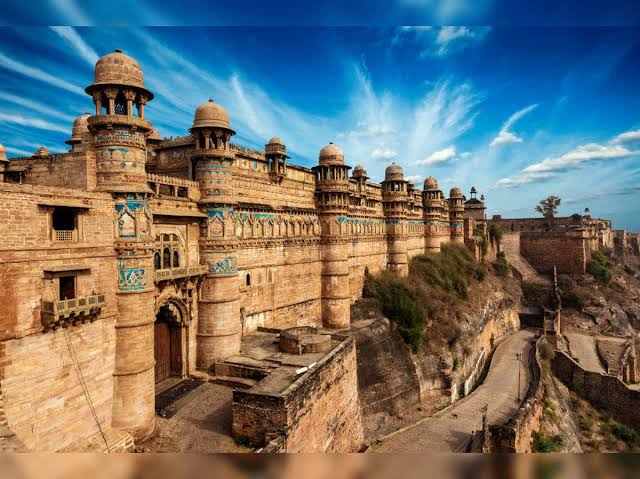
Gwalior Fort is one of the beautiful forts, stunning architecture, and unique history in Gwalior, Madhya Pradesh. It is one of the oldest and most impenetrable forts in the country. The construction of the fort is not yet known, there is not any solid proof. According to the local legend, the fort was built in 3 rd century by a local king called Suraj Sen. King Suraj Sen was suffering from the disease leprosy, he lost all hopes, but one day he met a sage named Gwalipa. The Sage Gwalipa came wandering to the fort and met the king. He gave him some water from a sacred pond (now called Suraj Kund and located within the fort complex), king Suraj Sen was getting rid of his disease and became healthy immediately. King Suraj Sen imparted honor to the saint named the fort and the town after him. Then Sage Gwalipa bestowed the king the title of ‘Pal’ (protector) and told him that if he and his family continue to bear this title, the fort would remain in their possession. Gwalior Fort has witnessed many ups and downs. It also changed hands many times and has been held by the Tomars, Mughals, Marathas, and the British, before finally being handed over to the Scindias. After independence, the Central Government took possession of this fort and has been taking care of it ever since. The fort spread an area of three square kilometers, height is more than 10 m. The iconic fort built on a hilltop offers a spectacular 360-degree view of the landscape around it. You will also catch glimpses of massive water tanks that were specifically designed to store water for weeks and months. The fort has two entrance gates the main entrance gate is named an Elephant Gate (Hathi Pul) on the north-east side with a long ramp and the second gate is called the Badalgarh Gate on the south-west side. Man, Mandir Palace sits on the northeast side. Jain temples form unique monuments inside the fort, with the Siddhachal Caves and Gopachal rock-cut Jain monuments being the two areas, complete with thousands of Jain Tirthankar idols defaced during the Mughal invasion. Teli Ka Mandir and Sahastrabahu (Sas-Bahu) Ka Mandir are the two architecturally rich Hindu temples here. Gurudwara Data Bandi Chhor is another holy place built inside the fort’s complex, and it was where Sikh Guru Hargobind Sahib was kept as a captive by Mughal Emperor Jahangir. Man Mandir Palace, Gujari Mahal, Assi Khamba Ki Baoli, and Suraj Kund are other important monuments found in the complex.
Golconda Fort
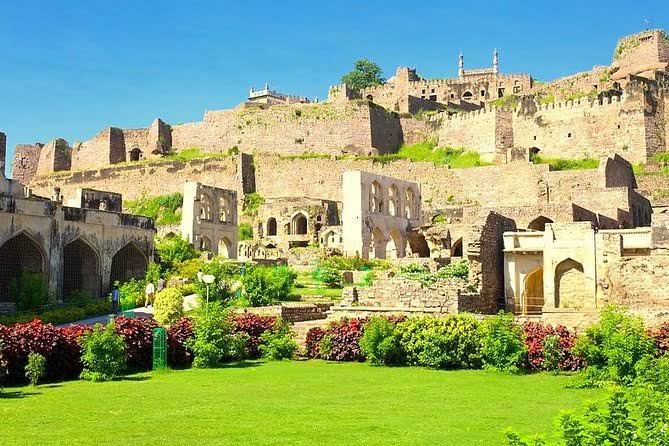
Golconda Fort is in Hyderabad city. Golconda is originally known as Mankal, and fort structured by Kakatiya king (South Indian Dynasty). When the Kakatiya was built the fort a shepherd boy found an idol of a god on the site that the reason fort was called Golla Konda or the Shepherd Hill. Firstly, the fort was originally made of mud. Kakatiya king was built in the 13th century after 200 years, Bahamani rulers took possession of the place. Later 16th and 17th centuries fort converted a massive granite extending around 5 kilometers in over 62 years. In 1686, the Mugal Emperor laid a siege to Golconda with his aim of expanding the kingdom. Golconda Fort has also had mines of Golconda, many famed diamonds Koh- i- Noor, Daria-i-Noor, Noor-ul-Ain, Hope diamond, prince diamond, Regent diamond, and many more. Fortis is full of such architecture it has four drawbridges, eight gateways, halls, magazines, stable, etc. The first door in the fort is called Fateh Darwaza meaning Victory gate. Fort has acoustic marvel, clapping your hand near the entrance which is heard clearly at the hill the top pavilion, this was the warning of any danger.
Mehrangarh Fort
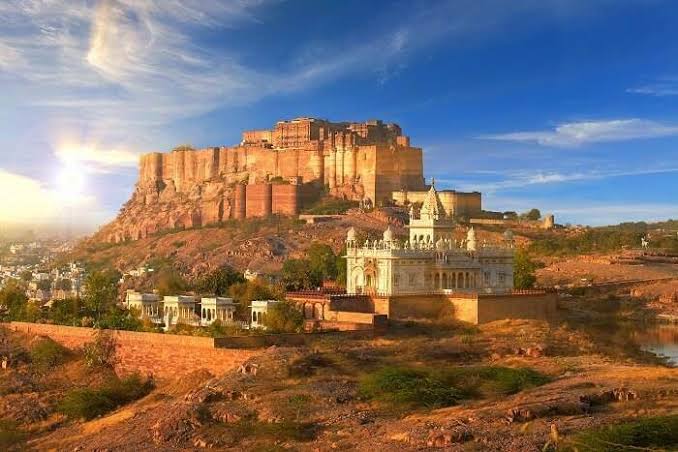
Mehrangarh fort is one of the largest forts, area 1200 acres located in the Jodhpur in Rajasthan. The fort has over 550 years old history. Mehrangarh Fort is also known as Mehran fort, Mehr meaning Sun, and Garh means fort. The sun has been the chief deity of the Rathore dynasty. It is believed that the Rathores are the descendants of the Sun. As per the pronunciation in the local language, Mehr-Garh came to be known as Mehrangarh. In 1459 Rao Jhodha has founded this massive fort, he shifted his capital for safety purposes so decided to make this fort in Jodhpur. It was constructed above 410 feet the city of Jodhpur, on a hill named Bhakurcheeria aka the Mountain of Birds. Mehrangarh Fort stands as a majestic citadel of colossal proportions. The fort and the structures within it were built over a long period of five centuries starting from the middle of the 15th century till the 20thcentury. So, its architecture reflects influences and elements from different eras, giving it a unique charm. The fort is spread over an area of 5 km and is built on a 125 m high hill in the outskirts of Jodhpur city. There are seven gates to enter inside the fort but at different times and for different reasons, the names of gates are Jai Pol, Loha Pol, Fateh Pol, Amrita Pol, Doodkangra Pol, Gopal Pol, and Bheru Pol. Mehrangarh, one of the best architectures in Jodhpur, is spread across an area of 5 km and is encircled by walls that are around 117 feet long and 70 feet wide. In some places, the walls of the fort rise to a height of 120 feet, which adds to its formidable structure.
Kangra Fort
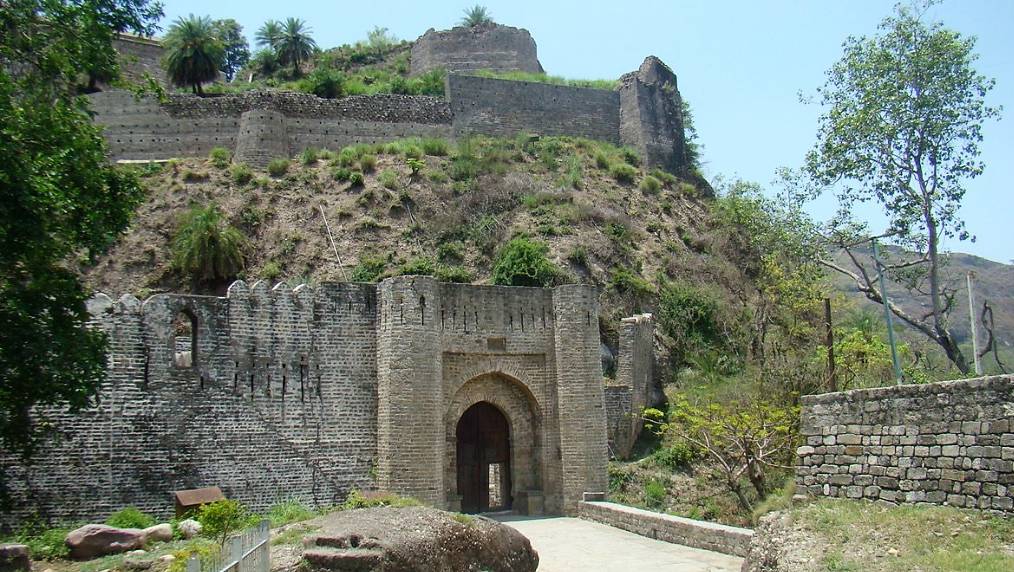
Kangra Fort is the oldest Fort around 3500 years ago and the largest fort in the Himalayan. The fort is located 20 km from Dharamshala in Himachal Pradesh. According to the local perspective, this fort was made by Maharaja Susharma Candra a descendant of a Katoch family. Maharaja Susharma Chandra is mentioned in the Mahabharat epic who fought the battle against Kaurav in the battle of Mahabharat after the battle he moved to Kangra and built this fort to protect his kingdom from possible attackers. Kangra fort area is 463 acres, and it is the 8th longest fort in India. The fort was under the possession of different dynasties starting from Mahmud of Ghazni to Ranjit Singh, the Maharaja of Punjab and Akbar made 52 failed attempts to capture this fort in the early 17th century. Only Jahangir was Quilt controlled by an appointed governor to regulate the turbulent chiefs of the hill. Sikhs were the last Indian ruler who possessed this fort before handing it over to the British Government. until a severe earthquake gave a jolt to its strong foundations in April 1905.
Jaisalmer Fort
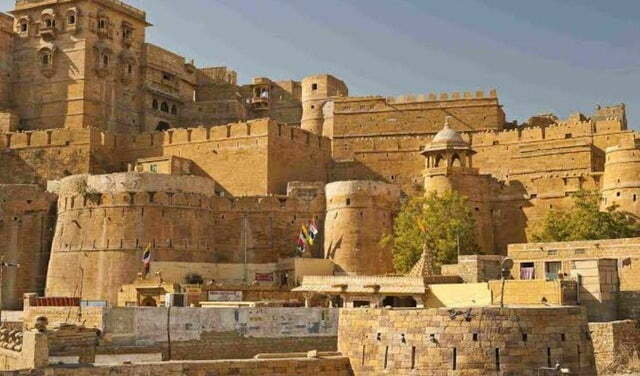
Jaisalmer Fort is the second oldest fort situated in the city of Jaisalmer, Rajasthan. Fort is 1500 ft long and 750 ft wide and is 250 ft height above the hill. The fort was built by Bhati Rajput Rawal Jaiswal in 1156 AD. He selected the Trikuta hills in the Thar Desert. The fort is also known as Sone Ka Quilla, Sonar Quilla, Golden fort. Fort made by yellow sandstone when the sun rays fall in this yellow sandstorm the whole fort is shining like gold so that’s the reason this fort is called as Sone Ka Quilla. When the sunrise rays fall on the fort the fort colors tawny lion yellow and in sunset fort colors honey gold the entire fort has an amazing view. Jaisalmer Fort is a combination of Islamic and Rajput architecture. Jaisalmer Fort is an affirmed world Heritage site UNESCO under the group hill fort of Rajasthan. The fort has many Havelis inside like Patwaon ki haveli, Nathmal ki haveli, Saalam Singh ki haveli, and many more. The fort of Jaisalmer several attacks by Muslim emperors like Ala-Uddin -Khilji, and Humayun.
Amber Fort
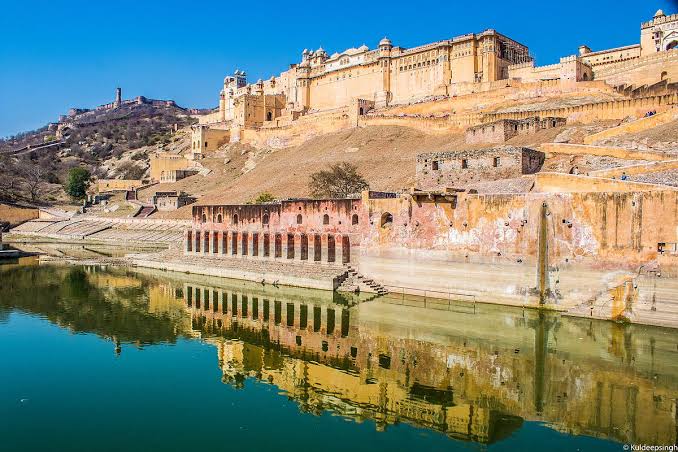
The Amer Fort is one of the most famous forts, it is also known as Amer Fort or Amber Fort is a fort located in Amer, Rajasthan, India. Amer, originally, was the capital of the state before Jaipur. Amer is a town with an area of 4 square kilometers located 11 kilometers from Jaipur, the capital of Rajasthan. In 1592, the fort was structured by Raja Man Sing, built-in red sandstone, yellow and pink sandstone, and with white marble and the Martha Lake to the entire Fort. Though the fort is too old, it is beautiful on the inside and boasts of various buildings of prominence like the ‘Diwan-i-Aam’, the ‘Sheesh Mahal’ and even the ‘Sukh Mahal’. The Amer Fort has influences of both Hindu and Muslim architecture. This fort also has the ‘Shila Devi’ Temple and the ‘Ganesh Pol’ which is a gate that leads to the private palaces of the kings. At the 37th session in 2013, Amer Fort, along with five other forts of Rajasthan, was declared a UNESCO World Heritage Site as part of the group Hill Forts of Rajasthan. Amer Fort is also popularly known as the Amer Palace. The palace was the residence of the Rajput Maharajas and their families. At the entrance to the palace near the fort’s Ganesh Gate, there is a temple dedicated to Shila Devi, a goddess of the Chaitanya cult, which was given to Raja Man Singh when he defeated the Raja of Jessore, Bengal in 1604. (Jessore is now in Bangladesh).
Amer, or Amber, derives its name from the Ambikeshwar Temple, built atop the Cheel ka Teela. Ambikashwara is a local name for the god Shiva. However, local folklore suggests that the fort derives its name from Amba, the Mother Goddess Durga.
The Palace is divided into six separate but main sections each with its own entry gate and courtyard. The main entry is through the Suraj Pol (Sun Gate) which leads to the first main courtyard. This was the place where armies would hold victory parades with their war bounty on their return from battles, which were also witnessed by the Royal family’s womenfolk through the latticed windows. This gate was built exclusively and was provided with guards as it was the main entry into the palace. It faced east towards the rising sun, hence the name. Royal cavalcades and dignitaries entered the palace through this gate.
Find more
Also read: Top 10 Freedom Fighters of India Independence
Also read:Azadi ka Amrit Mahotsav Essay in English
Also read:Most Important History MCQ Question
